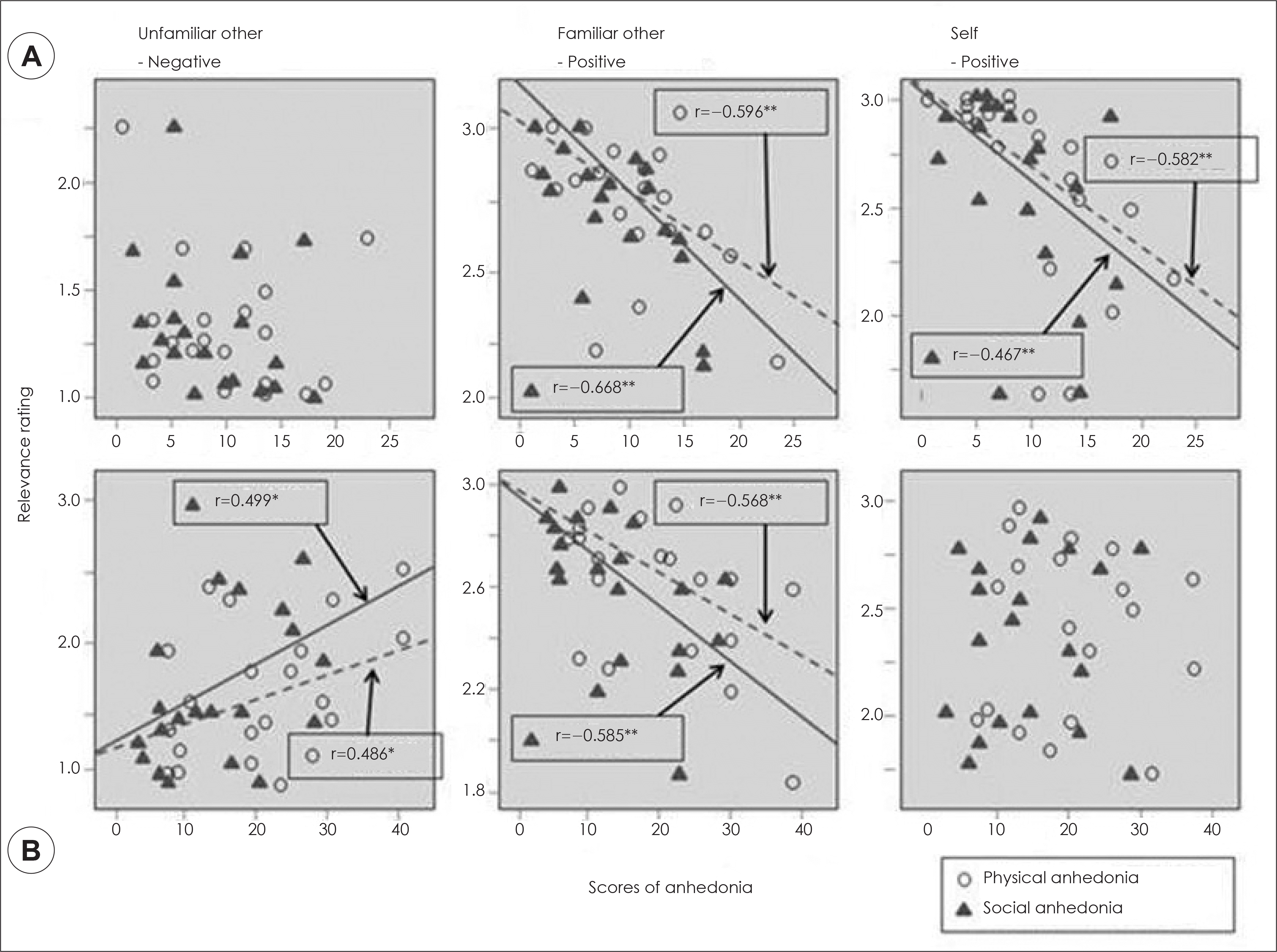Abstract
Objectives
The dysfunctional neural networks underlying self-evaluation in schizophrenia are overlapped with the neural structures involved in emotion regulation. The purpose of this study was to investigate the influence of anhedonia on the self-evaluation attitude of patients with schizophrenia.
Methods
Twenty healthy controls and twenty patients with schizophrenia performed a self-evaluation task, presenting a pair of the face (self, familiar other, and unfamiliar other) and word (negative, neutral, and positive noun) at the same time. Participants were asked to evaluate relevance between the pairs by pressing a corresponding button. Relevance rating scores were compared between the groups and were correlated with the severity of physical and social anhedonia.
Results
: Patients evaluated the condition of a self face with a negative word and a familiar face with a negative word to be more relevant than healthy controls. In the patient group, the scores of relevance rating in the condition of an unfamiliar other face with a negative word were positively correlated with the anhedonia scale scores (physical: r=0.486, p=0.030; social: r=0.499, p= 0.025). There was no correlation between the self-evaluation attitude and the severity of anhedonia.
References
1. Silverstone PH. Low self-esteem in different psychiatric conditions. Br J Clin Psychol. 1991; 30:185–188.

2. Northoff G, Heinzel A, de Greck M, Bermpohl F, Dobrowolny H, Panksepp J. Self-referential processing in our brain–a metaanalysis of imaging studies on the self. Neuroimage. 2006; 31:440–457.

3. Bedford NJ, Surguladze S, Giampietro V, Brammer MJ, David AS. Self-evaluation in schizophrenia: an fMRI study with implications for the understanding of insight. BMC Psychiatry. 2012; 12:106.

4. Fossati P, Hevenor SJ, Graham SJ, Grady C, Keightley ML, Craik F, et al. In search of the emotional self: an fMRI study using positive and negative emotional words. Am J Psychiatry. 2003; 160:1938–1945.

5. Johnson SC, Baxter LC, Wilder LS, Pipe JG, Heiserman JE, Prigata-no GP. Neural correlates of self-reflection. Brain. 2002; 125:1808–1814.

6. Northoff G, Bermpohl F. Cortical midline structures and the self. Trends Cogn Sci. 2004; 8:102–107.

7. Ochsner KN, Beer JS, Robertson ER, Cooper JC, Gabrieli JD, Ki-hsltrom JF, et al. The neural correlates of direct and reflected self-knowledge. Neuroimage. 2005; 28:797–814.

8. Schmitz TW, Kawahara-Baccus TN, Johnson SC. Metacognitive evaluation, self-relevance, and the right prefrontal cortex. Neuroimage. 2004; 22:941–947.

9. Pauly KD, Kircher TT, Schneider F, Habel U. Me, myself and I: temporal dysfunctions during self-evaluation in patients with schizophrenia. Soc Cogn Affect Neurosci;2013.
10. Barrowclough C, Tarrier N, Humphreys L, Ward J, Gregg L, Andrews B. Self-esteem in schizophrenia: relationships between self-evaluation, family attitudes, and symptomatology. J Abnorm Psychol. 2003; 112:92–99.

11. Holt DJ, Cassidy BS, Andrews-Hanna JR, Lee SM, Coombs G, Goff DC, et al. An anterior-to-posterior shift in midline cortical activity in schizophrenia during self-reflection. Biol Psychiatry. 2011; 69:415–423.

12. Blackwood NJ, Bentall RP, Ffytche DH, Simmons A, Murray RM, Howard RJ. Persecutory delusions and the determination of self-relevance: an fMRI investigation. Psychol Med. 2004; 34:591–596.

13. Cohen AS, Najolia GM, Brown LA, Minor KS. The state-trait disjunction of anhedonia in schizophrenia: potential affective, cognitive and social-based mechanisms. Clin Psychol Rev. 2011; 31:440–448.

14. Barch DM, Sheline YI, Csernansky JG, Snyder AZ. Working memory and prefrontal cortex dysfunction: specificity to schizophrenia compared with major depression. Biol Psychiatry. 2003; 53:376–384.

15. Heckers S, Weiss AP, Deckersbach T, Goff DC, Morecraft RJ, Bush G. Anterior cingulate cortex activation during cognitive interference in schizophrenia. Am J Psychiatry. 2004; 161:707–715.

16. Taylor SF, Phan KL, Britton JC, Liberzon I. Neural response to emotional salience in schizophrenia. Neuropsychopharmacology. 2005; 30:984–995.

17. Park IH, Kim JJ, Chun J, Jung YC, Seok JH, Park HJ, et al. Medial prefrontal default-mode hypoactivity affecting trait physical anhedonia in schizophrenia. Psychiatry Res. 2009; 171:155–165.

18. Association AP D-IA. Diagnostic and statistical manual of mental disorders: DSM-IV-TR:. Americal Psychiatric Publishing, Inc;2000.
19. Park JY, Oh JM, Kim SY, Lee MK, Lee CR, Kim BR, et al. Korean Facial Expressions of Emotion (KOFEE). Seoul, Korea: Section of Affect & Neuroscience, Institute of Behavioral Science in Medicine, Yonsei University College of Medicine;2011.
20. Chapman LJ, Chapman JP, Raulin ML. Scales for physical and social anhedonia. J Abnorm Psychol. 1976; 85:374–382.

21. Watson D, Clark LA, Tellegen A. Development and validation of brief measures of positive and negative affect: the PANAS scales. J Pers Soc Psychol. 1988; 54:1063–1070.

Fig. 1.
Expected mean scores of relevance rating in patients with schizophrenia and normal controls. A: There was a significant interaction effect of group and face because of the difference in unfamiliar face (t=3.69, p=0.0036). B: There was a significant interaction effect of group and word valence because of the difference in the negative word condition (t=4.92, p<0.0001).

Fig. 1.
Correlations between the severity of anhedonia and relevance rating. A: In normal controls, there was no significant correlation between anhedonia scale scores and relevance ratings in [unfamiliar other face-negative word] condition. Anhedonia scale scores were inversely correlated with relevance ratings in [familiar other face-positive word] and [self face-positive word] conditions. B: In patients with schizophrenia, anhedonia scale scores and relevance ratings were positively correlated in [unfamiliar other face-negative word] condition, but negatively correlated in [familiar other face-positive word] condition. However, they were not significantly correlated in [self face-positive word] condition. ∗: Significant finding at p<0.05, ∗∗: significant finding at p<0.001 after a Pearson correlation analysis.

Table 1.
Clinical characteristics of the subjects
Table 2.
Effect for behavioral responses in the self-evaluation task
Table 3.
Behavioral responses in the self-evaluation task




 PDF
PDF ePub
ePub Citation
Citation Print
Print


 XML Download
XML Download